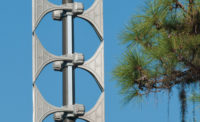Western Washington University‘s sprawling campus in scenic Bellingham stretches 215 acres, with nearly 15,000 students walking the grounds during the fall and spring semesters. The university gives prominence to campus safety, recently upgrading its fire alarm system in 47 buildings and adding a mass notification system featuring Technomad advanced audio loudspeakers to improve audio quality and long-distance coverage outdoors.
Mills Electric Co., a Bellingham-based electrical and systems contractor serving the commercial and industrial markets, installed the multi-zone audio system in conjunction with Western Washington University support staff. The project marries all indoor/outdoor PA points and associated Pelco pan/tilt/zoom cameras to an existing Edwards EST-3 campus-wide fire alarm system — tying every significant component to a central network infrastructure. The central fiber network routes campus-wide, with monitoring capabilities in every building.
The complete system enables administration, campus police and other offices to deliver voice notifications to any single location, multiple zones, or every PA point in an “all-call” scenario. When in mass notification mode, an amber-colored light blinks while the announcement is ground out — allowing campus officials to decide between making an audio notification and/or triggering a fire alarm.
“I have seen mass notification systems at other campuses but this is by far the most impressive,” said Cory Kovacevich, a service and project manager at Mills Electric Co. “This system eliminates the traditional separate public address system and combines it with the fire alarm system into a single powerhouse. The campus can still make regular announcements and quickly go into alert mode as needed, and localize announcements to specific buildings or areas. It’s designed to get the information to where it needs to go.”
Mills Electric Co. teamed with Performance System Integration on the project. Performance System Integration is an Edwards EST Life Safety and Communications Strategic Partner, responsible for programming and upgrading the fire alarm system. Kovacevich and his team focused on the audio portion, installing Technomad weatherproof loudspeakers outdoors in three zones. Technomad PowerChiton amplifier modules power all live and pre-recorded messages heard across the campus.
Kovacevich chose to install Technomad’s Berlin narrow dispersion loudspeakers to power the three zones, which are located at campus-designated “gathering areas.” In case of emergency, students are instructed to make their way to the closest gathering area, but the loudspeakers are powerful enough to broadcast emergency messages over long distances and to the furthest edges of the campus. Each gathering area includes two Technomad Berlin 90x40 loudspeakers, mounted between 20 and 90 feet from the ground depending on the location. The installation team used hoop-style brackets for mounting stability on older brick surfaces, adding safety chains around the brackets for additional safety.
“The Technomad loudspeakers produce intelligible voice over long distances, ensuring that students, staff and visitors hear emergency notifications loud and clear — there is no garble whatsoever,” said Kovacevich, adding that the 100-percent weatherproof construction of the loudspeakers ensures long-term durability and protection from the outdoor elements in rainy northwest Washington.
The PowerChiton modules are equally important to delivering high-quality sound. Each amplifier delivers 500 watts of clean power to the Berlins. Though IP66-rated and designed for permanent outdoor installation, Kovacevich installed the PowerChitons indoors at the central audio headend for easier accessibility.
“The PowerChitons come in small, non-metallic enclosures and take up minimal space, which is important because we have limited room to add equipment,” said Kovacevich. “The PowerChitons tie directly to the fire alarm system, and are mounted next to the fire alarm panels. This keeps everything but the loudspeakers and cameras in one building.”
The biggest challenge of the installation was grounding the feed coming into the amplifiers. The feed initially showed up as a ground fault on the main fire alarm panel as the PowerChitons were internally grounded —in contrast to how most fire alarm systems are designed.
“The fire alarm system has a built-in program to detect ground faults. The campus needed to be sure that ground faults would not affect the fire alarm system performance since the entire system was not grounded in a way it understood,” says Kovacevich. “The team working on the fire alarm system added a simple jumper for the loudspeakers, which eliminated the ground fault.”
Kovacevich notes that the overall system represents a major upgrade for the campus, enabling text-to-speech translation and remote access to make announcements over the system from off campus — in addition to video integration, multi-zone capability and superior audio quality.
“The Berlins put out some serious sound,” says Kovacevich. “We had recently broadcast a test message from the rooftop and saw people more than 100 yards away stop, turn around and look directly toward the loudspeakers. The university is very happy with the power, sound quality and clarity of the voice.”








